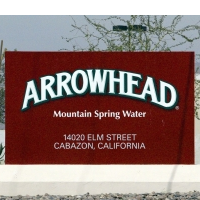Nestle Partners with Tribe for Under-the-Radar Groundwater Pumping in the Desert
 (photo: Damian Dovarganes, Associated Press)
(photo: Damian Dovarganes, Associated Press)
Not a lot is known about the decade-old groundwater-pumping deal between the Morongo Band of Mission Indians and Nestle Waters North America, bottlers of Arrowhead water near the city of Palm Desert, east of the San Bernardino Mountains.
The Morongo are a sovereign nation and Nestle is, well, Nestle, and, until the California drought kicked into high gear, grumbling about having a giant water bottling plant on tribal lands tapping springs that fed groundwater basins was kept to a minimum. The plant draws on water from a spring on the reservation in Millard Canyon, as well as other sources in the area.
It’s not as quiet now. Critics point to a decline in groundwater in the surrounding Cabazon area, the drought, and the wisdom of pumping and bottling water in the desert for shipment elsewhere. The Morongo, who hooked up with Nestle after paying the Cabazon Water District $3 million for the water rights, aren’t subject to the same oversight or reporting requirements as other entities because they are sovereign.
One of the perks of swapping a vast homeland for a piece of real estate on the edge of a desert is a measure of independence. In this case, it has also raised questions about what obligations the Morongo and Nestle have to disclose information about pumping and plant activities to facilitate regional management of a sparse, critical resource.
Millard Canyon is just one of a string of canyons, along with the San Gorgonio River, that feed water into 11 separate groundwater basins. In good times, i.e. no drought or excessive pumping, water might overflow the Cabazon basin into the Coachella Valley aquifer next door.
A book by Peter Gleick, “Bottled and Sold,” calculated that the Cabazon plant, which is powered by nearby wind turbines, was producing 1 billion bottles of water annually. But Desert Sun reporter Ian James detailed his frustration earlier this month at trying to get meaningful numbers about water usage.
The company and tribe wouldn’t tell him how much water was bottled up, he couldn’t wrangle a plant tour and Nestle stopped filing annual reports to local water districts after 2009. James did cite state reports from information provided by the tribe that around 600 acre/feet of water was pumped out of Millard Canyon in 2013, enough water for 400 households.
Hard feelings over water, as one might expect, and old resentments are not a new thing in the Cabazon area. The state has been squabbling with the tribe over one of its three licenses―this one for just 115 acre-feet of water―since 2003, according to the Desert Sun. The question over resurrecting unused antiquated water rights made it to the California Supreme Court over a procedural question, before the court gave the state permission to proceed with a hearing.
The newspaper quoted Palm Desert real estate appraiser Linda Ivey complaining about the morality of the situation. “Why is it possible to take water from a drought area, bottle it and sell it?” she asked. “We've got to protect what little water supply we have.”
Terri Hansen at the Indian Country Today Media Network wondered whether the Coachella Valley’s 124 golf courses and homes with water usage twice the national average might figure into that discussion.
–Ken Broder
To Learn More:
Little Oversight as Nestle Taps Morongo Reservation Water (by Ian James, The Desert Sun)
Drought in California’s Palm Springs Area Draws Attention to Nestlé Plant on Morongo Reservation (by Terri Hansen, Indian Country Today Media Network)
Nestle's Arrowhead Bottling Plant Responds to Aquifer Story (by Ian James and James Meier, The Desert Sun)
Selling Tap Water in Plastic Bottles (by Noel Brinkerhoff, AllGov)
- Top Stories
- Controversies
- Where is the Money Going?
- California and the Nation
- Appointments and Resignations
- Unusual News
- Latest News
- California Forbids U.S. Immigration Agents from Pretending to be Police
- California Lawmakers Urged to Strip “Self-Dealing” Tax Board of Its Duties
- Big Oil’s Grip on California
- Santa Cruz Police See Homeland Security Betrayal in Use of Gang Roundup as Cover for Immigration Raid
- Oil Companies Face Deadline to Stop Polluting California Groundwater





